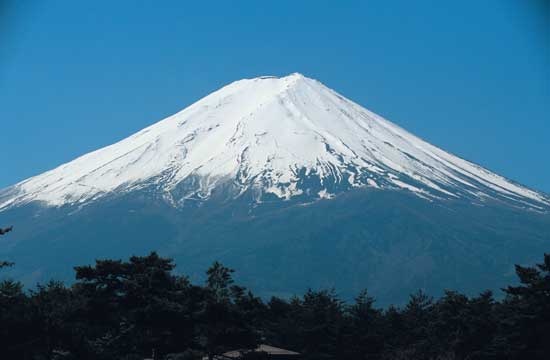Fuji, Mount
mountain, Japan
Japanese Fuji-san, also called Fujiyama, or Fuji No Yama
 highest mountain in Japan, rising to 12,388 feet (3,776 metres) near the Pacific coast in Yamanashi and Shizuoka ken (prefectures), central Honshu, about 60 miles (100 km) west of Tokyo. It is a volcano that has been dormant since its last eruption in 1707 but is still generally classified as active by geologists. The mountain's name, of Ainu origin, means “everlasting life.” Mount Fuji, with its graceful conical form, has become famous throughout the world and is considered the sacred symbol of Japan. Among Japanese there is a sense of personal identification with the mountain, and thousands of Japanese climb to the shrine on its peak every summer. The mountain is the major feature of Fuji-Hakone-Izu National Park (1936).
highest mountain in Japan, rising to 12,388 feet (3,776 metres) near the Pacific coast in Yamanashi and Shizuoka ken (prefectures), central Honshu, about 60 miles (100 km) west of Tokyo. It is a volcano that has been dormant since its last eruption in 1707 but is still generally classified as active by geologists. The mountain's name, of Ainu origin, means “everlasting life.” Mount Fuji, with its graceful conical form, has become famous throughout the world and is considered the sacred symbol of Japan. Among Japanese there is a sense of personal identification with the mountain, and thousands of Japanese climb to the shrine on its peak every summer. The mountain is the major feature of Fuji-Hakone-Izu National Park (1936).According to tradition, the volcano was formed in 286 BC by an earthquake. The truth is somewhat more complex. The age of Fuji is disputed, but it seems to be a Quaternary formation on a Tertiary base, the first eruptions and the first peaks probably occurring some 600,000 years ago. Although Mount Fuji appears to be a simple cone-type volcano, it is in fact three separate volcanoes, Komitake, Ko Fuji, and Shin Fuji. The most recent, Shin Fuji (“New Fuji”), first became active about 10,000 years ago and has continued ever since to smolder or erupt occasionally. Over the millennia, the lava and other effusions from Shin Fuji have covered over the two older volcanoes, enlarged the slopes to their present expansive girth, and otherwise given the mountain its current tapered form. The mountain is part of the Fuji Volcanic Zone, a volcanic chain that extends from the Mariana Islands and the Izu Islands through Izu Peninsula on up to northern Honshu.
The base of the volcano is about 78 miles (125 km) in circumference and has a diameter of some 25 to 30 miles (40 to 50 km). At the summit of Mount Fuji the crater spans about 1,600 feet (500 metres) in surface diameter and sinks to a depth of about 820 feet (250 metres). Around the jagged edges of the crater are eight peaks—Oshaidake, Izudake, Jojudake, Komagatake, Mushimatake, Kengamme, Hukusandake, and Kukushidake.
On the northern slopes of Mount Fuji lie the Fuji Five Lakes (Fuji Goko), comprising, east to west, Lake Yamanaka, Lake Kawaguchi, Lake Sai, Lake Shōji, and Lake Motosu, all formed by the damming effects of lava flows. The lowest, Lake Kawaguchi, at 2,726 feet (831 metres), is noted for the inverted reflection of Mount Fuji on its still waters. Tourism in the area is highly developed, with Lake Yamanaka, the largest of the lakes (at 2.5 square miles 【6.4 square km】), being the focus of the most popular resort area. Southeast of Mount Fuji is the wooded volcanic Hakone region, well-known for its hot-springs resorts at Yumoto and Gōra.
The area's abundant groundwater and streams facilitate the operation of paper and chemical industries and farming. Cultivation of rainbow trout and dairy farming are other activities.
A sacred mountain (one sect, the Fujikō, accords it virtually a soul), Mount Fuji is surrounded by temples and shrines, there being shrines even at the edge and the bottom of the crater. Climbing the mountain has long been a religious practice (though until the Meiji Restoration women were not allowed to climb it). The ascent in early times was usually made in the white robes of a pilgrim. Today great crowds flock there, mostly during the climbing season from July 1 to August 26.
- Sir Alec Issigonis
- Sir Alexander Burnes
- Sir Alexander Campbell Mackenzie
- Sir Alexander Carr-Saunders
- Sir Alexander Cunningham
- Sir Alexander Fleming
- Sir Alexander James Edmund, 10th Baronet Cockburn
- Sir Alexander James Edmund Cockburn, 10th Baronet
- Sir Alexander John, 1st Baronet Ball
- Sir Alexander John Ball, 1st Baronet
- Sir Alexander Korda
- Sir Alexander Mackenzie
- Sir Alexander Paterson
- Sir Alexander Tilloch Galt
- Sir Alfred Ewing
- Sir Alfred Hitchcock
- Sir Alfred Sharpe
- Sir Allen Lane
- Sir Alliott Verdon Roe
- Sir Almroth Edward Wright
- Charles C. Coffin: Four Years of Fighting
- Charles Chauncy
- Charles Cheney Hyde
- Charles, chevalier d' Éon de Beaumont
- Charles Chubb